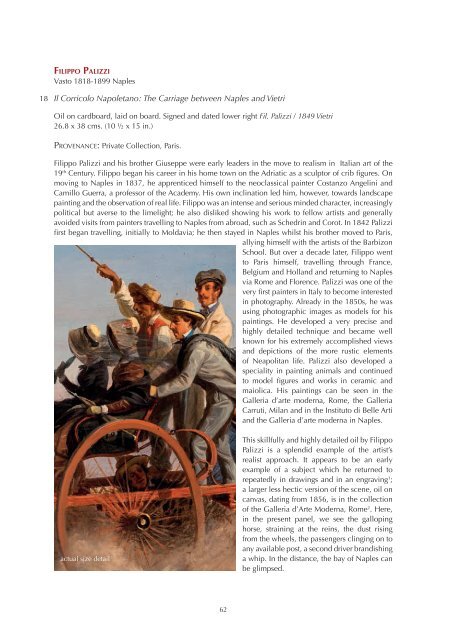Catalogue-2014-Jean-Luc-Baroni
- No tags were found...
Create successful ePaper yourself
Turn your PDF publications into a flip-book with our unique Google optimized e-Paper software.
Filippo Palizzi<br />
Vasto 1818-1899 Naples<br />
18<br />
Il Corricolo Napoletano: The Carriage between Naples and Vietri<br />
Oil on cardboard, laid on board. Signed and dated lower right Fil. Palizzi / 1849 Vietri<br />
26.8 x 38 cms. (10 ½ x 15 in.)<br />
Provenance: Private Collection, Paris.<br />
Filippo Palizzi and his brother Giuseppe were early leaders in the move to realism in Italian art of the<br />
19 th Century. Filippo began his career in his home town on the Adriatic as a sculptor of crib figures. On<br />
moving to Naples in 1837, he apprenticed himself to the neoclassical painter Costanzo Angelini and<br />
Camillo Guerra, a professor of the Academy. His own inclination led him, however, towards landscape<br />
painting and the observation of real life. Filippo was an intense and serious minded character, increasingly<br />
political but averse to the limelight; he also disliked showing his work to fellow artists and generally<br />
avoided visits from painters travelling to Naples from abroad, such as Schedrin and Corot. In 1842 Palizzi<br />
first began travelling, initially to Moldavia; he then stayed in Naples whilst his brother moved to Paris,<br />
allying himself with the artists of the Barbizon<br />
School. But over a decade later, Filippo went<br />
to Paris himself, travelling through France,<br />
Belgium and Holland and returning to Naples<br />
via Rome and Florence. Palizzi was one of the<br />
very first painters in Italy to become interested<br />
in photography. Already in the 1850s, he was<br />
using photographic images as models for his<br />
paintings. He developed a very precise and<br />
highly detailed technique and became well<br />
known for his extremely accomplished views<br />
and depictions of the more rustic elements<br />
of Neapolitan life. Palizzi also developed a<br />
speciality in painting animals and continued<br />
to model figures and works in ceramic and<br />
maiolica. His paintings can be seen in the<br />
Galleria d’arte moderna, Rome, the Galleria<br />
Carruti, Milan and in the Instituto di Belle Arti<br />
and the Galleria d’arte moderna in Naples.<br />
actual size detail<br />
This skillfully and highly detailed oil by Filippo<br />
Palizzi is a splendid example of the artist’s<br />
realist approach. It appears to be an early<br />
example of a subject which he returned to<br />
repeatedly in drawings and in an engraving 1 ;<br />
a larger less hectic version of the scene, oil on<br />
canvas, dating from 1856, is in the collection<br />
of the Galleria d’Arte Moderna, Rome 2 . Here,<br />
in the present panel, we see the galloping<br />
horse, straining at the reins, the dust rising<br />
from the wheels, the passengers clinging on to<br />
any available post, a second driver brandishing<br />
a whip. In the distance, the bay of Naples can<br />
be glimpsed.<br />
62
















